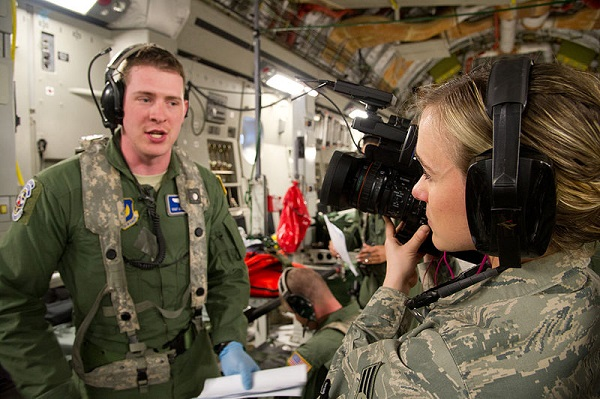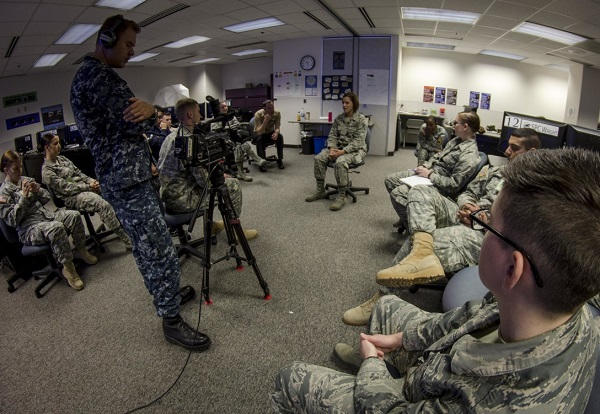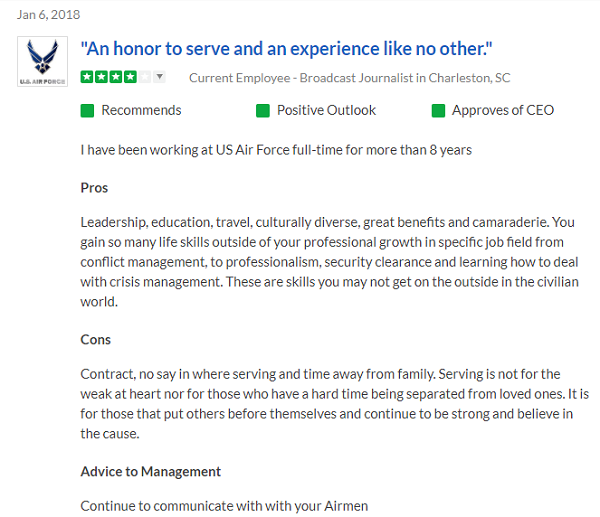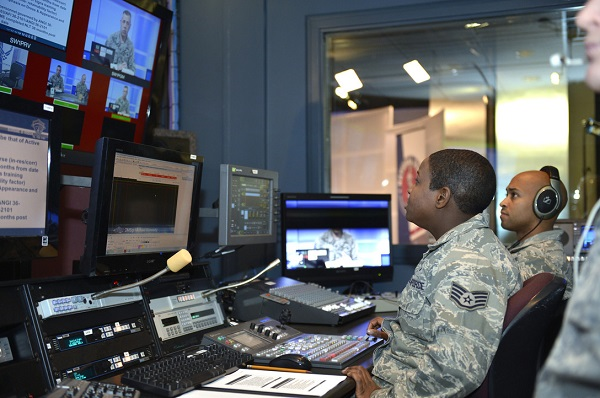Air Force Broadcast Journalist (3N0X2) have the important role of telling and recording the Air Force history.
In this position individuals can be in charge of a large variety of tasks from creating copy (articles, newsletters, press releases etc.) to being an on-camera announcer.
Air Force Broadcast Journalist is a great position for people who are good at writing, announcing, establishing relationships or are creative.
Education, Qualifications and Training
Education
Individuals who wish to join the Air Force in the Broadcast Journalist role are required to have at minimum a High School Diploma or GED.
Qualifications
Individuals will be asked to meet the general Air Force requirements on the ASVAB test.
As with most Air Force positions, you need to be between the ages of 17 and 39.
Related Article – Air Force Age Limit
Because of the position and the interactions individuals will have with different sources, favorable evaluation of voice audition is required.
You also cannot have a speech impediment and must have the ability to speak distinctly and clearly.
Broadcast Journalist should have knowledge of Basic Communication Theory.
They cannot have color blindness.
Having a valid driver’s license is required because you will operate government vehicles.
Because of the sensitivity of information that you will receive, it is required to complete a National Agency Check, Local Agency Check and Credit Check.
Training
Air Force Broadcast Journalist will complete 8.5 weeks of Basic Training.
After completing Basic Training, Broadcast Journalist head to Ft. Meade in Maryland for an average of 77 days of technical training.
The training facility at Ft Meade is not just for the Air Force but has a variety of recruits for different branches as well.
Training at the facility may be similar to attending college.
Training time may vary, but is mostly classroom setting and field work with a bit of free time in the evening.
What exactly does an Air Force Broadcast Journalist Do?

A Broadcast Journalist has more job positions than one might expect.
Creating Copy
Individuals who are in the Broadcast Journalist role will be required to create copy for both internal and external needs.
Creating copy could mean creating information for press releases, creating documents that will be filled in historical archives, creating news articles and documents.
Broadcast Journalists not only create copy but will learn the tools to edit and distribute the information as well.
This includes different programming and editing software.
In any situation Broadcast Journalist have the responsibility of creating captions for media and need to know exact details on who was there and involved.
Maintain and Operate Equipment
As an Air Force Broadcast Journalist, your role will involve maintaining and operating various cameras, microphones, lighting equipment and recording equipment.
Sometimes you will be working in a studio with the equipment and sometimes you will be in the field in more chaotic surroundings.
This career path involves determining what equipment is necessary and completing the research required to ensure that the subject matter is documented correctly.
Individuals will create the outlines for the shoot and work with all parties to make sure that the story is told correctly.
It is the responsibility of the Broadcast Journalist to check all equipment prior to use and to provide preventative maintenance for lasting equipment.
In the event of a technical malfunction, the Broadcast Journalist should be the person who knows how to resolve the issue quickly.
Choosing the Best Lighting and Camera Angles
It may be the Broadcast Journalist task to choose the right location for a shoot or video.
It will also be the Broadcast Journalist task to find the best lighting and camera angles.
Creating special effects and choosing the right equipment for the job are important as well.
Radio and Television Broadcast
Air Force Broadcast Journalist will create radio and television broadcast for internal and external purposes.
The Broadcast Journalist creates the broadcast and also is the announcer in the piece.
They will create the script, direct the production, host the production and even edit the material prior to distribution.
Broadcast Journalist then work with different media and television outlets to distribute the material.
Sometimes these productions will be remote productions or special event coverage.
Media Point of Contact
As Broadcast Journalist work in the field it will be their task to gain relationships with different media points of contact.
The relationship goes both ways.
The media wants to have a point of contact that they feel they can get reliable information from and good content.
A Broadcast Journalist wants to have a good relationship with the media because they want to have information about the released content and control over what is being released.
Having a good working relationship with local and regional media outlets could mean the difference between information being released that it should not be, or a picture painted of an event that depicts it differently than actual events.
Broadcast Journalist will be available at all media events and will escort/set-up and assist media personnel to briefings and interviews.
They will have the task of all communication between the Air Force and the Media.
Maintains History
Probably one of the most important media roles is the task of a Broadcast Journalist to maintain the history of the Air Force.
Maintaining history could be through the video, photographs, copy or broadcast created.
It also means maintaining the physical archive library to ensure future generations have accurate and plentiful information.
The history documented includes all combat and non-combat information.
What is the Pay Like for an Air Force Broadcast Journalist?
The pay for all enlisted in the Air Force is the same based on rank and years of service.
Related Article – Air Force Geospatial Intelligence (1N131): Career Profile
In addition to the pay table below, the Air Force offers many benefits.
| Insignia | Pay Grade | Rank | Abbreviation | 2023 Minimum Monthly Pay |
|---|---|---|---|---|
| E-1 +4 months | Airman Basic | AB | $1,917.60 | |
| E-2 | Airman | Amn | $2,149.20 | |
| E-3 | Airman First Class | A1C | $2,259.90 | |
| E-4 | Senior Airman | SrA | $2,503.50 | |
| E-5 | Staff Sergeant | SSgt | $2,730.30 | |
| E-6 | Technical Sergeant | TSgt | $2,980.50 | |
| E-7 | Master Sergeant | MSgt | $3,445.80 | |
| E-8 | Senior Master Sergeant | SMSgt | $4,957.20 | |
| E-9 | Chief Master Sergeant | CMSgt | $6,055.50 | |
| E-9 | Command Chief Master Sergeant | CCM | $6,055.50 | |
| E-9 | Chief Master Sergeant Of The Air Force | CMSAF | $6,055.50 |
When you join the Air Force, or any branch of the Military, you can receive free/low cost Medical and Dental benefits.
The Air Force also gives you a housing allowance and meal allowance.
You receive free housing if you live on the base or an allowance based on rank, family status and location if you live off of the base.
Air Force Broadcast Journalist, or anyone in the Air Force, will receive paid sick time, 30 days paid time off and a very generous retirement package.
Living on base also gives you access to a variety of recreational activities including gyms and family events.
The Air Force offers a few different opportunities for furthering your education.
You can receive up to 100% off your tuition with the Air Force Tuition Assistance Program, the Post 9/11 GI Bill or the Montgomery GI Bill.

Job Reviews
When looking at reviews from people who are in the Air Force Broadcast Journalist position, their outlooks are positive.
They mention being satisfied with their positions and overall career.
Some negative points that they mention include having strict deadlines and reporting to multiple agencies.
Related Article – Pros And Cons Of Joining The Air Force
Here is a review from a Broadcast Journalist:

Civilian Job Opportunities
The skills that you learn as an Air Force Broadcast Journalist will allow you to have many civilian job opportunities.
The job opportunities that you can apply for include:
- Reporter
- Producer
- Camera Tech
- Radio Host
- Digital Reporter
- Writer
The list includes any other position in television or radio media.
You will have learned skills that allow you to gain a position with government and private agencies all over the world.
References:
- 5 Worst Jobs in the Air Force - June 20, 2024
- 4 Steps For Visiting An Air Force Recruiter Near You - June 19, 2024
- Air Force Safety Specialist (1S0X1) - June 19, 2024




